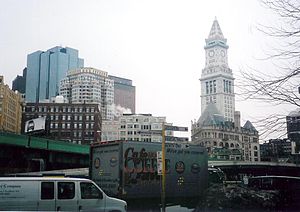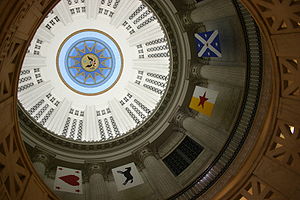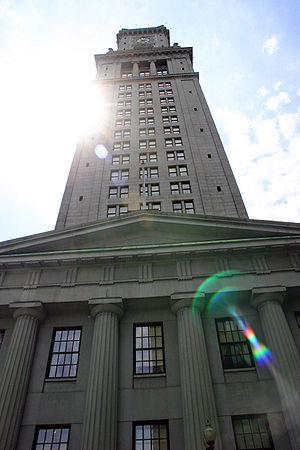- Custom House Tower
-
Custom House Tower 
General information Type Hotel Location 3 McKinley Square, Boston, Massachusetts Coordinates 42°21′32.65″N 71°03′12.13″W / 42.3590694°N 71.0533694°WCoordinates: 42°21′32.65″N 71°03′12.13″W / 42.3590694°N 71.0533694°W Completed 1915 Height Roof 496 ft (151 m) Technical details Floor count 32 Design and construction Architect Peabody, Stearns & Furber Developer Jung Brannen Associates, Inc The Custom House Tower - now Marriott's Custom House Hotel - is a skyscraper in McKinley Square, in the Financial District neighborhood of Boston, Massachusetts, in the United States. Construction began in the mid-19th century; the tower was added in the 1910s. Standing at 496 feet (151 m) tall, the tower is currently Boston's 17th-tallest building.
The tower is part of the Custom House District, added to the National Register of Historic Places in 1973.
Contents
Original building
The site was purchased on September 13, 1837. Construction of a custom house was authorized by U.S. President Andrew Jackson. When it was completed in 1849, it cost about $1,076,000, in contemporary U.S. currency, including the site, foundations, etc.[1]
Ammi Burnham Young entered an 1837 competition to design the Boston Custom House, and won with his neoclassical design. This building was a cruciform (cross-shaped) Greek Revival structure, combining a Greek Doric portico with a Roman dome, resembled a four-faced Greek temple topped with a dome. It had 36 fluted Doric columns, each carved from a single piece of granite from Quincy, Massachusetts; each weighed 42 tons (37 metric tons)[2] and cost about $5,200.[3] Only half these actually support the structure; the others are free-standing. They are 5 feet (1.5 m) and 4 inches (162 cm) in diameter and 32 feet (9.7 m) high.[2] Inside, the rotunda was capped with a skylight dome.
The entire structure sits on filled land and is supported by 3,000 wooden piles driven through fill to bedrock.[2] Before land reclamation was done in the mid-19th century, Boston's waterfront extended right to this building.[1] Ships moored at Long Wharf almost touched the eastern face of the building. The Custom House was built at the end of the City docks, to facilitate inspection and registration of cargo.[2] The federal government used the building to collect maritime duties in the age of Boston clipper ships.[4]
This description of the original Custom House appears in the 1850 Boston Almanac:
- Situated at the head of the dock between Long and Central Wharves, fronts east on the dock, west on India Street, and is in the form of a Greek Cross, [with] the opposite sides and ends being alike. It is 140 feet (43 m) long north and south, 75 feet (23 m) wide at the ends, and 95 feet (29 m) through the centre. It is built on about 3,000 piles, fully secured against decay; the construction throughout is fireproof and of the very best kind.
- The exterior of the building is purely Grecian Doric, not a copy, but adapted to the exigencies and peculiarities of the structure, and consists of a portico [overhang] of 6 columns on each side, on a high flight of steps, and an order of engaged columns around the walls, 20 in number, on a high stybolate or basement; the order of engaged columns terminating with 4 andae [pilasters] at their intersection with the porticos. The columns are 5 feet 4 inches (1.63 m) in diameter and 32 feet (9.8 m) high, the shaft being in one place, each weighing about 42 tons.
- The cellar, which is 10 feet 6 inches (3.20 m) high to the crown of the arches, is principally used for the storage of goods, which are conveyed to it through the basement story. The steam apparatus for warming the whole building (which it does effectively) is situated in the cellar, having easy access to the coal vaults under the sidewalk outside of the building.
- The principal entrances to the basement story are at each end. They are for the receipt of goods for storage. Near the northwest corner, on the west side, is the entrance to the Night Inspectors' apartments, also to the private staircase leading to the Collector's room and the attic. South of the west portico is the entrance to the heating apparatus room, and on the south end is the entrance to the Custom House Truckmen's room. This story consists of rooms for the Night Inspectors, Custom House Truckmen, and Engineer of the Heating Apparatus, also three sets of Water Closets: the remainder is used for storage of goods, weigher's tabs, etc.
- The principal ingress to the entrance story is through the porticos, but it can be entered from the Collector's private staircase, and from two other private staircases in the basement. This story contains apartments and offices for the Assistant Treasurer, the Weighers and Gaugers, the Measurers, Inspectors, Markers, Superintendent of Building, etc. In the centre is a large vestibule, from which two broad flights of steps lead to the principal story, landing in two smaller vestibules therein, lighted by skylights in the roof, and these vestibules communicate with all the apartments in this story. The several rooms are for the Collector, Assistant Collector, Naval Officer, Surveyor, Public Store Keeper, their Deputies and Clerks; and for the facilities of doing business this arrangement is not surpassed. The grand-cross shaped Rotunda, for the general business of the Collector's department, in the centre of this story, is finished in the Grecian Corinthian order; it is 63 feet (19 m) in its greatest length, 59 feet wide, and 62 feet (19 m) in the skylight.
- In one of the panels of the Rotunda is inserted a tablet of marble (Dedication Tablet 1847), containing the following inscription: Boston Custom House Building. Authorized by the 23d Congress, A.D. 1835. Andrew Jackson, President U.S.A.; Levi Woodbury, Sec'y of the Treasury.—Opened August 1st, A.D. 1847, James K. Polk, President U.S.A.; Robert J. Walker Sec'y of the Treasury; Marcus Morton, Collector of the Port; Samuel S. Lewis, Robert G. Shaw, Commissioners; Ammi Burnham Young, Architect.
Tower
By 1905, increased shipping required the building's expansion. In 1913–1915, the architecture firm Peabody and Stearns added the tower to the base. Although Boston at that time had a 125-foot (38-m) height restriction, the Custom House was federally owned and exempt from it. The new tower's 496 feet (151 m) made it the city's tallest. In 1947, the Old John Hancock Building, just one foot shorter, joined it in the skies over Boston. In 1964, it was exceeded by the Prudential Tower. The clock on the upper tower of the building is 22 feet (6.7 m) in diameter. Because of an undersized motor, it failed to work properly through much of the 20th century.[5] In 1960, the Great Seal of the United States was painted in the lobby's dome.
Current use
When custom officials moved to the Thomas P. O'Neill building in 1986, the Custom House was declared "surplus property". On April 16, 1987, the city of Boston purchased the building from the General Services Administration. The building remained unoccupied and inaccessible for 14 years. Working with the Boston Redevelopment Authority, The Landmarks Commission and Massachusetts Historical Society, The Beal Companies and Jung/Brannen Associates, Inc. proposing concepts ranging from museums to offices to residential developments. In 1995, The Beal Companies and Marriott Ownership Resorts International announced plans to develop it into a time-share resort, with Jung Brannen Associates retained as Architects.[6] It was converted into an 87-room Marriott Vacation Club starting in 1997.
One of the greatest challenges facing the design team was the limited square footage of usable space on each of the tower floors, and one of the primary reasons that redevelopment into modern use had posed such a problem. In order to transform the Custom House into a financially viable real estate asset for Marriott, the team had to maximize the size and number of suites that could be located in the building. Working around the tower’s structural constraints, the project team devised ways to fit four to five suites with custom-designed built-in cabinetry and furnishings, on each floor. This resulted in the creation of 87 one-bedroom suites with 22 different floorplan designs. A private owner’s lounge, an exercise area and a game room are a few of the other amenities designed into the project. Also designed into the project was significant public access: a new ground floor and rotunda-level maritime museum and exhibit space, and guided tours of the refurbished observation deck on the tower’s 26th floor.[6]
Pressley Associates, Inc. is the landscape architecture that redesigned the front plaza in 1999 "It provides a new urban linkage space that provides a sense of cohesion between Custom House Tower, Faneuil Hall and Marketplace Center." "As part of the current rehabilitation of the Tower to hotel use, the mandate of the landscape architectural design was to unify and revitalize the urban environment while respecting the buildings' historical importance. A 1-acre (4,000 m2) plaza has been designed to encourage pedestrian access and use, and to relate contextually to the adjacent Faneuil Hall Markets and Marketplace Center through the extensive use of large caliper shade trees, brick and granite pavements, and high quality site furnishings. The scope of work provided includes site design, construction documents, approvals process, presentations, resident engineering and construction support services.[7]
See also
References
- ^ a b Boston Custom House Tower, The City's First Real Skyscraper
- ^ a b c d Custom House - iBoston.org
- ^ http://thomascranelibrary.org/legacy/history/hisch3.htm
- ^ Education - Historic Markers - Downtown
- ^ Clockworking - The Boston Globe
- ^ a b TRO Jung|Brannen :: Boston :: Memphis :: Sarasota :: Birmingham :: Beijing :: Dubai
- ^ "http://www.pressleyinc.com/portfolio/custom.html"
External links
- Marriott's Custom House - official site
- Short tour of the tower with some photos and views from the top
- Emporis.com
- The custom house on google maps
Current John Hancock Tower · Prudential Tower · Federal Reserve Bank Building · One Boston Place · One International Place · First National Bank Building · One Financial Center · 111 Huntington Avenue · Two International Place · One Post Office Square · One Federal Street · Exchange Place · 60 State Street · One Beacon Street · One Lincoln Street · 28 State Street · Custom House Tower · Berkeley Building · 33 Arch Street · State Street Bank Building · Millennium Place Tower I · 125 High Street · 100 Summer Street · Millennium Place Tower II · McCormack Building · Keystone Building · Harbor Towers I · One Devonshire Place · Harbor Towers II · Saltonstall Building · 500 Boylston Street · Ames BuildingProposed Approved Under construction See also Preceded by
Church of the CovenantTallest Building in Boston
1915–1964
151 mSucceeded by
Prudential TowerCategories:- Buildings and structures completed in 1849
- 1915 architecture
- Landmarks in Boston, Massachusetts
- Skyscrapers in Boston, Massachusetts
- Peabody and Stearns buildings
- Jung Brannen buildings
- Skyscrapers between 150 and 199 meters
- Rotundas
- Financial District, Boston
- Custom houses in the United States
- Government buildings in Massachusetts
- Clock towers in the United States
Wikimedia Foundation. 2010.




